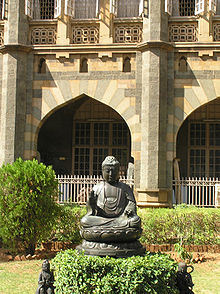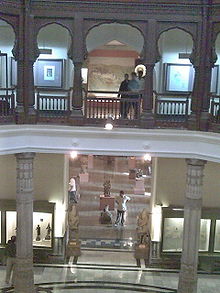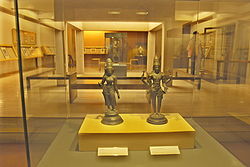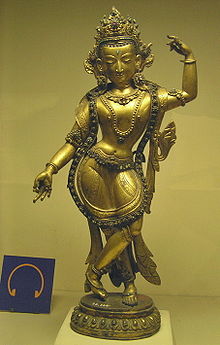- Chhatrapati Shivaji Maharaj Vastu Sangrahalaya
-
Coordinates: 18°55′36″N 72°49′56″E / 18.926667°N 72.832222°E
Chhatrapati Shivaji Maharaj Vastu Sangrahalaya
छत्रपती शिवाजी महाराज वस्तुसंग्रहालय
formerly Prince of Wales Museum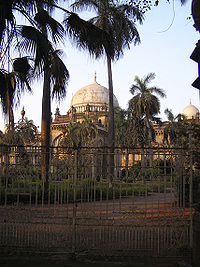
Established January 10, 1922 Location M. G. Road, Fort, Mumbai, India Collection size approx. 50,000 artefacts[1] Director Sabyasachi Mukherjee[2] Website http://www.themuseummumbai.com/home.aspx The Chhatrapati Shivaji Maharaj Vastu Sangrahalaya (Marathi: छत्रपती शिवाजी महाराज वस्तुसंग्रहालय, Vastu Sangrahalaya means museum in Marathi), formerly Prince of Wales Museum of Western India, Mumbai (formerly Bombay), India was founded in the early years of the 20th century by some prominent citizens of Bombay, with the help of the government, to commemorate the visit of the then Prince of Wales. It is located in the heart of South Mumbai near the Gateway of India. The museum was renamed in the 1990s after Shivaji, the founder of Maratha Empire.
The museum building is built in the Indo-Saracenic style of architecture, incorporating elements of other styles of architecture like the Mughal, Maratha and Jain. The museum building is surrounded by a garden of palm trees and formal flower beds.
The museum houses approximately 50,000 exhibits of ancient Indian history as well as objects from foreign lands, categorized primarily into three sections: Art, Archaeology and Natural History. The museum houses Indus Valley Civilization artefacts, and other relics from ancient India from the time of the Guptas, Mauryas, Chalukyas and Rashtrakuta.[3]
Contents
History
In 1904, some leading citizens of Bombay decided to provide a museum to commemorate the visit of the Prince of Wales, the future King George V. On June 22, 1904, the committee passed a resolution saying, "The building should have a handsome and noble structure befitting the site selected, and in keeping with the best style of local architecture".[4] The foundation stone was laid by the Prince of Wales on the 11 November 1905 and the museum was formally named "Prince of Wales Museum of Western India".[1]
On March 1, 1907, the Government of the Bombay Presidency granted the museum committee a piece of land called the "Crescent Site", where the museum now stands. Following an open design competition, in 1909 the architect George Wittet was commissioned to design the Museum building. Wittet had already worked on the design of the General Post Office and in 1911 would design one of Mumbai's most famous landmarks, the Gateway of India.[4]
The museum was funded by the Royal Visit (1905) Memorial Funds. Additionally, the Government and the Municipality granted Rs. 3 lacs and Rs. 2.5 lacs respectively. Sir Currimbhoy Ibrahim (first Baronet) donated another Rs. 3 lacs and Sir Cowasji Jehangir, gave half a lac. The Museum was established under Bombay Act No. III of 1909. The museum is now maintained by annual grants from the Government and the Bombay Municipal Corporation. The latter pays for these grants from the interest accruing on the funds at the disposal of the Trust of the Museum.[5]
The museum building was completed in 1915, but was used as a Children's Welfare Centre and a Military Hospital during the First World War, before being handed over to the committee in 1920. The Prince of Wales Museum was inaugurated on January 10, 1922, by Lady Lloyd, the wife of George Lloyd, Governor of Bombay.[5][6]
The museum building is a Grade I Heritage Building of the city and was awarded the first prize (Urban Heritage Award) by the Bombay Chapter of Indian Heritage Society for heritage building maintenance, in 1990.[1][6] The Museum was renamed "Chhatrapati Shivaji Maharaj Vastu Sangrahalaya" after the founder of Maratha empire - Shivaji, following the renaming of the city, when the colonial name "Bombay" was replaced by the native "Mumbai".[1]
Architecture
The museum building is situated in 3 acres (12,000 m2) area, having a built up area of 12,142.23 sq.m.[1] The museum building is surrounded by a garden of palm trees and formal flower beds.[7]
The museum building, built of basalt and kurla stone, is a three-storied rectangular structure, capped by a dome set upon a base, which adds an additional storey in the centre of the building. Built in the Western Indian and Indo-Saracenic style of architecture, the building accommodates a central entrance porch, above which rises a dome, "tiled in white and blue flecks, supported on a lotus - petal base". A cluster of pinnacles, topped with miniature domes surround the central dome. The building incorporates features like Islamic dome with a finial along with protruding balconies and inlaid floors, inspired by Mughal palace architecture. The architect, George Wittet, modeled the dome on that of Golconda Fort and the inner vaulting arches on those at the Gol Gumbaz in Bijapur.[6][7] The interior of the museum combines the columns, railings and balcony of an 18th century Wada (a Maratha mansion) with Jain style interior columns, which form the main body of the central pavilion below the Maratha balcony.[6]
In its recent modernization programme (2008), the Museum created 30,000 sq ft (2,800 m2) space for installation of five new galleries, a conservation studio, a visiting exhibition gallery and a seminar room, in the East Wing of the Museum.[1] The Museum also houses a library.[1]
Collections
The museum collection comprises approximately 50,000 artefacts.[1] The collection of the museum is categorized primarily into three sections: art, archaeology and natural history. The museum also houses a forestry section, which has specimens of timbers grown in the Bombay Presidency (British India), and one exhibiting a small local geological collection of rocks, minerals and fossils.[5] The Maritime Heritage Gallery,which displays objects relating to navigation, is the "first of its kind in India".[8] In 2008, the Museum installed two new galleries, displaying the "Karl and Meherbai Khandalavala collection" and "the Coins of India".[1]
Art section
The art section displays the collections of Sir Purushottam Mavji, acquired in 1915, and the art collections of Sir Ratan Tata and Sir Dorab Tata, donated in 1921 and 1933 respectively.[7]
The museum's miniature collection encompasses representations of the main schools of Indian painting namely, Mughal, Rajasthani, Pahari and Deccani. It features palm leaf manuscripts dating to the 11th-12th centuries to the early 19th century pahari paintings, as well as paintings from the Sultanate period.[7] Notable manuscripts housed in the museum include the Anwar-Suhayli painted in Mughal emperor Akbar’s studio and a 17th Century manuscript of the Hindu epic Ramayana from Mewar.[8]
The ivory section has artefacts dating as early as the Gupta era.[7] The museum also has decorative artefacts such as textiles, ivories, Mughal jades, silver, gold and artistic metal ware. It also has a collection of European paintings, Chinese and Japanese porcelain, ivory and jade artefacts.[7] The museum also has sections dedicated to arms and armour and another to Nepali and Tibetan art.[8] The arms and armour section contains a finely decorated armour of Akbar dating to 1581 CE, consisting of a steel breastplate and a shield, the former inscribed with religious verses.[9]
Archaeological section
Sculptures and coins transferred from the Poona Museum in Pune and the collections of the Bombay branch of the Royal Asiatic Society resulted in the development of an archaeological section, with precious sculptures and epigrams.[7] The Indus Valley Culture Gallery houses fishing hooks, weapons, ornaments and weights and measures from the Indus Valley Civilization (2600–1900 BCE).[8] Artefacts from the excavation of the Buddhist stupa of Mirpurkhas, were housed in the Museum in 1919.[1] The sculpture collection holds Gupta (280 to 550 CE) terracotta figures from Mirpurkhas in Sind of the early 5th century, artefacts dating to the Chalukyan era (6th-12th century, Badami Chalukyas and Western Chalukyas), and sculptures of the Rashtrakuta period (753 – 982 CE) from Elephanta, near Mumbai.[7]
Natural History section
The Bombay Natural History Society aided the Museum Trust in creating the natural history section.[7] The museum's natural history section makes use of habitat group cases and dioramas, along with diagrams and charts, to illustrate Indian wildlife, including flamingoes, Great Hornbill, Indian bison, and the tiger.[7]
New galleries
As part of renovation project initiated in October 2008, the "Krishna Gallery" holding artworks related to the Hindu god Krishna was opened in March 2009. A textile gallery, the first gallery in the city, is going to be opened in April 2010. It will illustrate "various techniques of textile manufacturing, regional collections and traditional Indian costumes".[2] Matrika Design Collaborative is currently designing the museum's Indian Miniature Painting Gallery. The content developed for the gallery will be converted into Braille text and tactile labels for the blind with help from designers, fabricators and consultants from the Hellen Keller Institute.
References
- ^ a b c d e f g h i j k Press Information Bureau: Union Ministry of Culture (September 5, 2008). "Union Ministry of Culture give Administrative approval for 12.43 crore Rupees for Modernization of Chhatrapati Shivaji Maharaj vastu Sangrahalaya, Mumbai". http://www.pibmumbai.gov.in/scripts/detail.asp?releaseId=E2008PR703.
- ^ a b Mahorey, Sumedha (July 13, 2009). "New-Seum!". Mumbai Mirror. http://www.mumbaimirror.com/index.aspx?Page=article§name=News%20-%20City§id=2&contentid=20090713200907130258416406f04a997. Retrieved 2009-07-13.
- ^ Desai, Kalpana (2002). Jewels on the Crescent: Masterpieces of Chhatrapati Shivaji Maharaj Vastu Sangrahalaya (Illustrated ed.). Mapin Publishing. pp. 356. ISBN 978-1-890206-44-4. http://books.google.com/books?id=1-CzQgAACAAJ&dq=Jewels%20on%20the%20Crescent.
- ^ a b "Official site". http://www.bombaymuseum.org/.
- ^ a b c Maharashtra state gazetteers, Greater Bombay District. "Places: PRINCE OF WALES MUSEUM". http://www.maharashtra.gov.in/english/gazetteer/greater_bombay/places.html#46.
- ^ a b c d "Architectural Note on the Building of Prince of Wales Museum of Western India, Mumbai". http://www.bombaymuseum.org/powm/bldgarch.htm.
- ^ a b c d e f g h i j Maharashtra Tourism Development Corporation, Govt. of India. "CHHATRAPATI SHIVAJI MAHARAJ VASTU SANGRAHALAYA". http://www.maharashtratourism.gov.in/mtdc/HTML/MaharashtraTourism/Default.aspx?strpage=../MaharashtraTourism/MaharashtraMusems/Prince_Museums.html.
- ^ a b c d Maharashtra Tourism Development Corporation (2004). "Mumbai Museums". http://www.maharashtratourism.gov.in/MTDC/HTML/MaharashtraTourism/Default.aspx?strpage=../MaharashtraTourism/Articles/Mumbai_Museums.html.
- ^ Brend, Barbara (1991). Islamic art (Illustrated ed.). Harvard University Press. pp. 212. ISBN 067446866X. http://books.google.com/books?id=ba3LyiGfPU8C&pg=PA212&dq=akbar+armour+mumbai+museum. Retrieved 2009-04-04.
External links
 Tourist attractions in Mumbai
Tourist attractions in Mumbai 
Pre-colonial
 ColonialChhatrapati Shivaji Terminus · BMC Headquarters · Hutatma Chowk · Worli Fort · David Sassoon Library · Gateway of India · Rajabai Tower · Mount Mary's Church · Crawford Market · Chhatrapati Shivaji Maharaj Vastu Sangrahalaya · Bombay High Court · Ballard Bunder Gatehouse · South Mumbai
ColonialChhatrapati Shivaji Terminus · BMC Headquarters · Hutatma Chowk · Worli Fort · David Sassoon Library · Gateway of India · Rajabai Tower · Mount Mary's Church · Crawford Market · Chhatrapati Shivaji Maharaj Vastu Sangrahalaya · Bombay High Court · Ballard Bunder Gatehouse · South Mumbai BeachesGirgaum Chowpatty · Dadar Chowpatty · Juhu Beach · Versova Beach · Madh Island · Aksa Beach · Marvé Beach · Powai Lake
BeachesGirgaum Chowpatty · Dadar Chowpatty · Juhu Beach · Versova Beach · Madh Island · Aksa Beach · Marvé Beach · Powai LakePlaces of worship Mumba Devi Mandir · Mahalaxmi Temple · Siddhivinayak temple · Shitala Devi Temple · Walkeshwar Temple · Swaminarayan Mandir · Haji Ali · Mahim ChurchCultural National Centre for the Performing Arts · Jehangir Art Gallery · Taraporewala Aquarium · National Gallery of Modern Art · Asiatic Society of Mumbai · Marine Drive · Royal Opera House · Regal Cinema · Eros Cinema · Metro Adlabs · Nehru Science Centre · Film City · Capitol Cinema · Liberty CinemaBoulevards Marine Drive · Fashion Street · Linking Road · Nepean Sea Road · Breach Candy · Bandstand Promenade · Worli Seaface · Bandra-Worli Sea Link Districts
DistrictsShopping  Buildings
BuildingsParks, zoos
and stadiaHanging Gardens · Gowalia Tank · Sanjay Gandhi National Park · Kamala Nehru Park · Jijamata Udyaan · Horniman Circle Gardens · Cross Maidan · Brabourne Stadium · Wankhede Stadium · Mahalaxmi Racecourse · Shivaji Park · Mumbai Port Trust Garden · Essel World · Water KingdomCategories:- Museums in Maharashtra
- History museums in India
- Mumbai culture
- Visitor attractions in Mumbai
- Museums established in 1922
- 1915 architecture
- 1922 establishments in India
- Natural history museums in India
- Art museums and galleries in India
Wikimedia Foundation. 2010.


